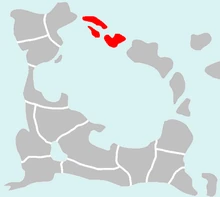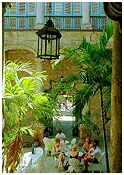Motto | |||||||
| Anthem | "Aeterna Gloria Seluciae (Luthorian: Eternal Glory of Selucia)" | ||||||
| Capital | Auroria | ||||||
| Largest city | Auroria | ||||||
| Other cities | Victoria, Argona, Assedo | ||||||
| Language | Selucian | ||||||
| Religion main |
Religio Seluciana | ||||||
| others | Irreligion, Aurorian Hosianism, Ahmadism | ||||||
| Ethnic Groups main |
Selucians | ||||||
| others | Shadaris, Raktavanis, Majatrans, Jelbics | ||||||
| Demonym | Selucian | ||||||
| Government | One-party semi-presidential republic | ||||||
| Cōnsul | Caius Clodius Eonus | ||||||
| Prōconsul | Aulus Junius Carantus | ||||||
| Legislature | Senātus Populī | ||||||
| Area | 369.900 km² | ||||||
| Population | 89,495,465 (5441 estimate) | ||||||
| GDP Total: |
| ||||||
| per capita | |||||||
| Established | 5376 (current Republic) 1811 (first Republic) | ||||||
| Currency | Selucian Denarius ( | ||||||
| Time Zone | GMT 0 | ||||||
| summer | GMT +1 | ||||||
| Drives on the | Left | ||||||
| Calling Code | +35 | ||||||
| Internet TLD | .su | ||||||
| Organizations | World Congress | ||||||
The Selucian Republic (Selucian: Res Publica Seluciana) is a country in Majatra. As an island country, Selucia has no land borders but it shares maritime borders with Cildania to the east, Pontesi to the west and Malivia to the north. Located south of the islands is the Majatran Sea.
History[]
Selucia's history is closely intertwined with that of the rest of the continent of Majatra, as well as the former Selucian colonies in Seleya, Keris, and Dovani. Although Selucia was unified for the first time only in 1811 CE, there was a sense of pan-Selucian culture before that time. Since 533 CE Selucia has been one of the primary centers of Hosianism, serving as the headquarters of the Holy Apostolic Hosian Church of Terra until its dissolution, and in modern times the Selucian Patriarchal Church and its successor the Aurorian Patriarchal Church.
Geography[]
Selucia is comprised of three main islands, known as Sadaria, Oleria, and Aquilonia, and numerous smaller ones. Selucia straddles the Equator, so its climate is relatively even year-round. Selucia experiences two seasons, a dry season between May and October and a wet season between November and April. Selucia's climate is tropical and, in some places, desertic, however it is moderated by the sea, and in the inland by mountains and inner valleys. The three major islands were originally volcanic islands and contain several active volcanoes. As none of the Selucian islands was part of a continent, native flora and fauna reached Selucia through long-distance dispersal. Selucia is home to several endemic species.
Government and Politics[]
The Republic of Selucia is crowned demarchic republic, with a legislative selected by sortition, an advisory executive body known as the Senate, and a elected monarch known as the Prince of the Republic as the head of state. The Council of the Plebs is the supreme legislative body of the Republic, and it is randomly selected from among Selucian citizens who served as municipal officers. The Tribunate of the Plebs is the cabinet of the Head of Government, the Tribune of the Plebs. The Tribunate of the Plebs is comprised of the Tribune of the Plebs and twelve ministers known as Plebeian Aediles.
Council of the Plebs (Concilium Plebis)[]
The Concilium Plebis (Council of the Plebs), and sometimes simply known as the Senate, is the legislative body of Selucia, and it has 75 seats. There are 30 Plebs from Aquilonia, 30 Plebs from Sadaria, and 15 Plebs from Oleria, making 75. Each council member is is a representative from their Prefecture (Province) and Comitatus (County), and each Comitatus directly elects 2 representatives, and those 2 representatives then go on to run against each other to become a Pleb in the council. The winning candidate then becomes a Pleb for their Comitatus and Prefecture. The term length is 4 years, and the maximum terms a Pleb is able to serve is 3.
Tribunate of the Plebs (Tribunatus Plebis)[]
The Tribunatus Plebis (Tribunate of the Plebs), is the cabinet of the Tribunus Plebis (Executive Leader of Selucia), and is comprised of the Tribune of the Plebs, and 12 ministers, who are appointed by selection from the Head of Government, and then the Council of the Plebs vote on whether to approve that selection.
Tribune of the Plebs (Tribunus Plebis)[]
The Tribunus Plebis (Tribune of the Plebs), is the executive leader of Selucia, and is elected directly through a popular vote by the citizens of Selucia. They have a cabinet, the Tribunate of the Plebs, that has 12 ministers and themselves.
Administrative divisions[]
Selucia is a centralized republic where subnational administrative divisions do not enjoy autonomy. Selucia is divided into three Prefectures, corresponding to the three major islands that compose the Selucian archipelago. The chief executive in a Prefecture is known as a Praetorian Prefect. Each Prefecture is governed by a Praetorian Prefect, appointed by the Aedile (Minister) of Internal Affairs.
The three Prefectures are in turn divided into Civitates and Municipia. Civitates and Municipia are governed under a system mixing sortition and election, each being endowed with a legislative assembly (known as a Concilium), selected by lot from local citizens, a number of allotted bodies with rules setting (known as the Decuriones) and agenda setting (the Aediles) powers, and an elected local executive, known as the Quaestores.
| Prefecture | Flag | Population | Area | Capital |
| Oleria | 
|
25,785,695 | 59,700 km² | Victoria |
| Sadaria | 
|
26,950,721 | 184,200 km² | Argona |
| Aquilonia | 28,241,718 | 126,000 km² | Auroria |
Cities[]
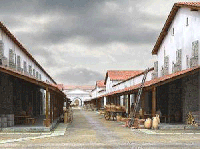
A Selucian village
Selucia has 10 major metropolises and numerous medium-sized towns and small villages. By far the largest city in Selucia is Auroria, founded according to tradition around 800 B.C.E. In the 8th century BCE, Auroria was build up and functioned as the main trading market for the neighbouring districts and regions in Corgana. Her place near the sea and her port also helped her to become a keystone for trading with Sadaria Island. Auroria's importance stems from its position as the official headquarters of the largest religious denomination on Terra, the Aurorian Patriarchal Church, as well as its long history as Selucia's capital for many centuries. Other major cities include Victoria, Argona, Assedo, and Nabal.
The three Selucian islands are connected by a public transport system, TransInsula.
Demographics[]
Ethnicity[]
The dominant ethnic group in Selucia is the Selucian people, an Enetric ethnicity distantly related to Kalopians and more closely to Selucic peoples such as Augustans, Canrillaise, or Ushalandans. In addition to Selucians living on the islands since ancient times, this group also encompasses various people of mixed ethnic and cultural backgrounds, a legacy of Selucian colonization, that primarily identifies as Selucian.
Most ethnic minorities in Selucia originate in the neighboring nations of Malivia, Cildania, Pontesi, and Barmenistan. The largest minority in Selucia is the Shadari people, closely related to the Qildari and Hebilean people in neighboring Cildania. Shadaris are notable for preserving the Shadari language, a dialect of the otherwise nearly extinct Qildari language, but most Shadaris are native speakers of Selucian. Raktavanis, originating from Malivia and Vascania, constitute the second largest minority in Selucia. Another large minority is the Jelbics, who arrived on the islands following various waves of immigration, especially as a result of several Selucian occupations of Pontesi and the expulsion of Felinists from Barmenistan.
The Majatran community contains mostly Badaran and Kafuristani people, in addition to Majatrans from Pontesi and Barmenistan. They arrived Selucia as a result of trade and as a consequence of wars. Today they are a stronghold in Selucia's maritime trade with Majatran nations. Around 1.6 million persons are of Majatran origin who seem to prefer the Sadaria island as their primary living point.
Religion[]

A Selucian Pagan marriage
For much of its history Selucia was marked by a deep conflict between Hosianism and Religio Seluciana, with either having the upper hand and persecuting the other during different times in Selucian history. The dominant religion in Selucia Religio Seluciana, also known as Selucian Paganism, a native polytheistic religion worshiping a pantheon of 27 main gods and numerous minor divinities and spirits. Religio Seluciana was given its modern form in the 19th century when it was accepted as the national faith of Selucia. Over time the Religio was expanded after the acceptance of several other polytheistic religions, such as Hosio-Paganism, Felinism, or Geraja, as valid expressions of Selucian Paganism.
Although now a minority religion, Hosianism has a long presence in Selucia, where the city of Auroria served as the headquarters of the Holy Apostolic Hosian Church of Terra and its modern successor, the Selucian Patriarchal Church, which entered communion with the Theognosian Church in 3876 to form the Aurorian Patriarchal Church. In 4834 roughly half of the Aurorian population formally left the Aurorian Patriarchal Church to form the competing Selucian Aurorian Church. Today however the largest Hosian denomination practiced in Selucia is the Apostolic Church of the Isles, headquartered in neighboring Cildania. Several other Hosian denominations are also practiced in the nation.
- Paganism 50%
- Religio Seluciana 35%
- Hosio-Paganism 10%
- Geraja 2%
- Felinism 1%
- Satanism 1%
- Other 1%
- Irreligious 35%
- Hosianism 10%
Religio Seluciana[]
A plurality of Selucians are considered "Pagan", an umbrella term covering all polytheistic religions practiced in Selucia and subject to the authority of the "College of Pontiffs". The native religion of Selucia is Religio Seluciana, also known as Cultus Deorum, the polytheistic native faith of the Selucian people. The Religio was once the dominant religion in the nation but was replaced in that role by the Selucian Patriarchal Church, after which Religio Selucia was declared a religio illicita and its practice banned. Beginning with the 37th century the Religio has experienced a slow resurgence, and by the beginning of the 49th century Pagan religions collectively became a plurality in Selucia.
Irreligious[]
Selucia has a significant irreligious population, including atheists, agnostics, deists, spiritual but not religious, etc. Mostly emerging as a reaction to various Hosian theocratic regimes in Selucia, the irreligious population traditionally allied itself with the Pagan population. In recent times the irreligious population has grown to become the second largest religious demographic.
Hosianism[]
Hosianism, the largest religion in Terra, has a minor presence in Selucia, where it was once the dominant faith. There are three major churches with some presence in Selucia, namely the Apostolic Church of the Isles, the Aurorian Patriarchal Church, and the Selucian Aurorian Church, the latter two having their headquarters in the nation. The Apostolic Church of the Isles, a Church part of the Apostolic Church of the East and headquartered in neighboring Cildania, has a small but significant presence, mostly among ethnic Shadaris. The Aurorian Patriarchal Church and the Selucian Aurorian Church are Patriarchal denominations claiming direct continuity with the Holy Apostolic Hosian Church of Terra, the first international Hosian Church, which was headquartered in Selucia. The Aurorian Patriarchal Church was founded in 3876 with the merger of the Selucian Patriarchal Church and the Theognosian Church following the Second Council of Auroria, and the Selucian Aurorian Church was founded in 4834 when a breakaway faction within the Aurorian Patriarchal Church joined the Union of Nordland.
Other Religions[]
Several large religions of Terra, mainly Ahmadism and Yeudism, have minority representation in the Selucian population. Members of these religions often tend to form close-knit communities, to maintain their religious independence. Ahmadism is mostly present in southern Oleria and Sadaria with outposts in Aquilonia in the regions around Auroria and Assedo. On the other side, there is the Yeudish community which is spread over the nation.
Education and Culture[]

A Selucian café in Auroria
Selucian culture is very diverse, as each province and town has its own unique customs and traditions. Selucian culture is heavily influenced by its two largest religious traditions, Aurorian Hosianism and Selucian Polytheism. Owing to the islands' tropical climate, Selucians still walk in traditional robes; the tunica is the essential Selucian item of clothing, worn by both men and women. Men also wear a toga over the tunic, while women cover their tunics with a stola, over which they often wear a pala.
Most of Selucia's streets are wide, with trees along the sides, giving the feeling of great allées. The sidewalks are made out of granite, the plazas paved with marble. One can often see groups of women walking up and down the streets carrying their shopping purchases home or stopping along the way to chat with their friends under the shade of the larger trees.
Selucian culture is rich in festivities and arts. There are three kinds of Selucian marriage: A more traditional and religious one, a traditional family marriage and a marriage by living together for a minimum of one year. All of these are celebrated with friends and family. The religious marriage ceremony is divided into Hosian and Pagan customs, although apart from the religious ceremony itself, there is little difference between them.
When a family member dies 6 professional mourners are called, always women, to cry and express how sad and shocked the family is. The body is placed on a bed for 3 days to offer all family members and friends the chance to say their goodbyes. After this, the body is either buried, if the person was a Hosian or burned and the ashes placed in an urn if a Pagan.
The daily life is influenced by Selucia's tropical climate. The people are sitting in the different cafes and cigar lounges, discuss daily news on the fora (marketplaces) or just make a trip to the beach and relax in the sun or ride a wave.
Selucian educational system is highly praised and respected around the world. Especially in recent centuries, the level of Selucian science and educational system has increased ostensibly, putting itself at the forefront of the nations of Terra. Selucia counts with the SuCoSQua, the Selucian Superior Council of Scientific Investigations, and it is a global leader in scientific research. On 4909, Selucian representatives at the First Terran Mathematics Olympiad were praised for their performance, with Selucian mathematicians far and above the strongest in the competition and their performance at the first Terran Mathematics Olympiad being named as a "badge of honor for their nation's educational and mathematical prowess".[1]
Universities[]
Ludi Gladiatorum[]
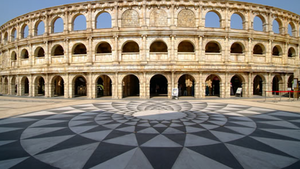
Colosseum Imperiale
The Ludi Gladiatorum is one of the biggest games in Selucia. The first game was held in 347 BCE and since then the strict rules haven't changed. It can be bloody and can even lead to death but this doesn't often happen. People cheer the gladiators and a successful fighter can become very rich and very well known, a real hero.
Each provincial capital and also most of the bigger towns have an arena for these games. There are special gladiator schools to train the participants before one of them ever sees the arena. While in ancient times prisoners of war were trained to fight in the arena, today this is a voluntary option. It is always a fight between two men, each of whom chooses one of the four fighter 'archetypes' once they begin their training.
But it is not easy to gain the merits and reach the overall goal of success. The way to the Colosseum Imperiale in Auroria is difficult as there is a strict hierarchy to claim the top. You have to become successful and well known to receive an invitation to the next higher level of the arena. In the normal way, a gladiator starts on the regional level somewhere in the Imperial Provinces. After several successful fights and a good reputation, he might get an invitation by a next higher Circus to impress the spectators there. Once if he fights in one of the provincial capitals his reputation is high enough to be able to climb the highest level, the Colosseum Imperiale.
Parks and Gardens[]
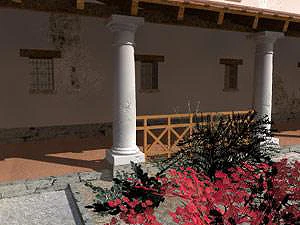
A garden in the backyard of a Selucian home
Selucian citizens have a fine flair for gardens and parks. Not only the upper class likes to have a garden in their backyard but also the normal people who are living in their own houses. It is pretty popular to have odorous and colourful flowers and shade-providing trees or bushes. Families who want to spend a bit more money often have a fountain in the middle of their garden to impress visitors.
But this is the private sphere only. In public, Selucia is proud to have not only medium sized gardens for a short work break but also wide parks with arrangements of trees, flowers, fountains and sculptures of Selucian poets, Imperatores and other important Selucians. Some parks are so big you need more than an hour to walk through them to reach the other side. These big parks are often used for festivities and family holiday trips.
One of the biggest parks is the Imperial Park. Its arrangement contains lakes, eucalyptuses, colourful flowerbeds, cypresses, marmoreal statues, the gods' pantheon and the Imperators' mausoleum where all Selucian Imperators are buried. Fountains and little resting places are also part of the arrangement. Last but not least the major families also founded some parks over the past centuries.
Royal Palaces[]
See main article: Vestanius Palacio
Economy[]
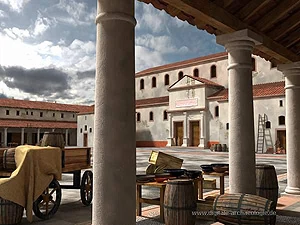
A village marketplace
According to the Global Economic Register, as of 4878 Selucia is considered a high-income country. It is ranked as the 10th biggest economy by GDP, with an unemployment of just 2% thanks to its economic and labor policies and an inflation rate of 2%.[2] Its economy is based on manufacturing, extraction, and agriculture, producing a wide spectrum of products as well as some important raw materials. It is also one of the nations with the highest investments in science and technology during the recent decades. Selucian economy is heavily dependent on exports, and as such it possesses a large merchant fleet of at least 750 ships of all sizes. As a founding member of SOTO and owing to its position between Majatra and Artania, several foreign companies and nations have founded trading posts and merchant companies in Selucia. Though Auroria is the most important keystone the city of Assedo plays a major role for the northern trade-routes and sea-lanes as well.
Selucia guarantees a safe and secure sea not only in the national waters but also in those waters which are part of SOTO. For this measure, Selucia provides permanent sea and air patrols. Selucia has to import most of the oil consumed, though minor oil fields are present. The gold and silver mines in the mountains are used to pay for imports, and to produce jewelry. Coffee and tobacco are among the major export goods beside marble, sugar cane and wine.
Military[]
The Selucian Army, Selucian Navy, Selucian Air Force, and the Republican Guard collectively form the Armed Forces of Selucia. A fifth branch, the Selucian Security, was abolished in 3838 due to its involvement in numerous human rights abuses and lack of civilian oversight. The armed forces are under the joint command of the Consuls, and the Ministry of Defense is responsible for the civilian administration of the Armed Forces of Selucia. In 3838 the Armed Forces had 746,700 personnel on active duty. As of 5131, the Armed Forces had 650,000 personnel in total, 510,000 on active duty, and 140,000 on reserve.
RANKS OF THE SELUCIAN MILITARY[]
GENERALS OF THE SELUCIAN ARMY[]
General Augustus Anatolia
Lieutenant General Titus Vesta
Lieutenant General Valentina Venus Florencia
Major General Caesar Quirinus
Major General Antonius Silvius
Brigadier General Marcus Pollux
Brigadier General Albus Evander
Brigadier General Mariana Longa
ADMIRALS OF THE SELUCIAN NAVY[]
Fleet Admiral Julius Italus
Fleet Admiral Camillus Aurelius Diocletianus
Fleet Admiral Faustus Augurnus
Admiral Mamilius Parnesius
Admiral Horensio Vorenius
Admiral Augustus Lentulo
Admiral Ausonia Sila Asprenas
Admiral Manilia Remosio
Vice Admiral Cornelius Ruricius
Vice Admiral Mettius Caesonius Nicasius
Vice Admiral Flavian Lucan
Vice Admiral Tadia Armina
Vice Admiral Servius Junius Lepidus
Rear Admiral Cassia Marcella
Rear Admiral Paulus Caesennius Vitalion
Rear Admiral Vel Laberius Maecius
Rear Admiral Caius Liburnius Bibaculus
Rear Admiral Pontidia Patuisna
Rear Admiral Horatio Senecius
MARSHALLS OF THE SELUCIAN AIR FORCE[]
Air Chief Marshal Lucius Amabilion
Air Chief Marshal Cocceius Zeusio
Air Chief Marshal Decius Ennecus
Air Marshal Potitus Revus Morio
Air Marshal Artania Galerus
Air Marshal Caesar Ibania
Air Marshal Fufia Valentinian
Air Vice-Marshal Julianus Laberius Macrobius
Air Vice-Marshal Servius Octavio
Air Vice-Marshal Agrippa Vispanius
Air Commodore Catalina Licinius
Air Commodore Xanthes Posidena
Air Commodore Albina Sestus
Air Commodore Tiberius Artanius
Air Commodore Decimus Caeso
Public Holidays[]
| Date | Observations | |
| New Year's Day | January 1 | New Year |
| Lustrum & Ludi Taurei | January | Lustrum and Taurian Games, usually celebrated in January; no fixed date |
| Selucian Unification Day | March 7 | Commemoration of the unification of the first Selucian state |
| Women's Day | March 9 | Only for women |
| Ludi Terrestres | April 4 to April 10 | Games honoring Terra Mater |
| Ludi Floralenses | April 27 | Games honoring Floralia |
| Coelestis Voluptates | May 1-20 | Games honoring peace, prosperity, and culture |
| Diversity Day | June 30-July 1 | Celebration of Selucian Diversity |
| Ludi Aplenses | July 13-21 | Games honoring Aplus |
| Ludi Seluciani | September 5-19 | Celebration of the Selucian National Games. |
| Liberty Day | November 10 | Fall of the fascist regime |
| Ludi Plebeii | November 4–17 | Games honoring Orgius and celebrating Plebeian political liberty |
| Nations of Majatra | |
|
| |



